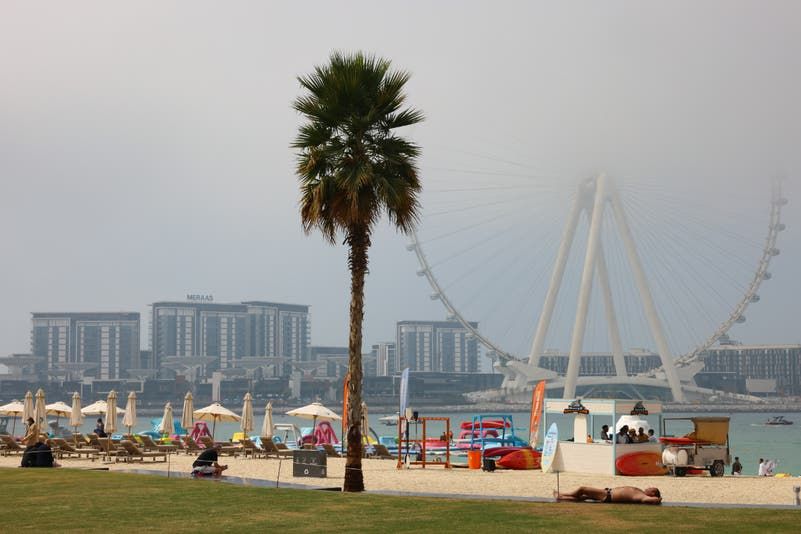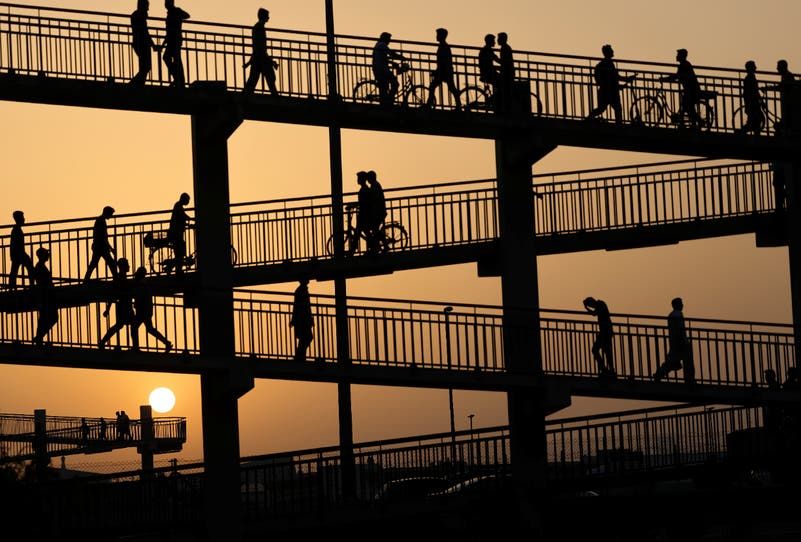
UAE hospitals see rise in heatstroke patients; doctors suggest ways to stay safe
“We have seen an increase in the number of patients admitted to our hospital for Heat-related illnesses this summer,” Dr. Ahmed Raza Khan, Internal Medicine at Bareen International Hospital in MBZ City, told Al Arabiya English.
Meanwhile, Dr. Zuhair al-Sharafi, Emergency Consultant and Director of Emergency Services at Burjeel Medical City, said, “We have been seeing daily cases of heat syncope, heat exhaustion and heat stroke since the rise in temperature after the onset of summer, mainly affecting those who work outdoors.”
He also noted that due to the midday break in outdoor work, the number of severe heatstroke cases has decreased.
 People gather at a beach across from the Ain Dubai Ferris wheel, on a
foggy day on January 21, 2021, in the Gulf emirate of Dubai.
People gather at a beach across from the Ain Dubai Ferris wheel, on a
foggy day on January 21, 2021, in the Gulf emirate of Dubai.
“Sun exposure, especially during high temperatures, can have serious health consequences,” he added, warning that certain factors can have a direct impact on the outcomes of sun exposure. These factors include atmospheric temperature, time spent under the sun, humidity, hydration status, chronic illnesses, and certain medications.
“Heat stroke can [happen] to anyone, but it affects mostly blue-collar workers and athletes after having strenuous exercise in a hot and humid environment,” Khan said.
There are four types of heat-related illnesses: rashes and muscle cramps, heat syncope (dizziness), heat exhaustion and heatstroke.
Tips to beat the heat
Heatstroke is the most serious heat-related illness, and it occurs when one’s body can no longer control its temperature. The body’s temperature rises rapidly, the sweating mechanism fails, and subsequently, the body is unable to cool itself down, resulting in heatstroke.
 People cross an overhead bridge amid soaring humidity and temperatures in the Gulf emirate of Dubai, on June 24, 2022.
People cross an overhead bridge amid soaring humidity and temperatures in the Gulf emirate of Dubai, on June 24, 2022.
“Heatwaves can lead to an increase in body temperature that in turn triggers water and mineral loss, which can lead initially to symptoms of heat exhaustion, such as: weakness, fatiguability, dizziness, headache, and nausea,” al-Sharafi told Al Arabiya English.
“Prevention is the best approach to avoiding heat-related illness,” he continued, advising people to stay indoors during peak heat hours to avoid intense direct sun exposure.
“When you visit public spaces, it is advisable to go closer to sunrise or sunset. It is essential to consume enough water to stay sufficiently hydrated and prevent the losses of electrolytes, while avoiding caffeinated beverages,” he added.
Al-Sharafi also suggested wearing loose-fitting, light-colored clothing and to avoid activities directly under the sunlight, especially during peak heat hours.
“Protect yourself by wearing sunscreen and sunglasses,” he said.
Despite its dangers, heatstroke can be easily avoided, according to Khan.
“Heat stroke can be [avoided] easily by having good hydration by drinking plenty of fluids, wearing sun-protective clothes and hats use shades and umbrellas during work outside,” Khan said.
He also suggested that people park their cars in shaded areas and to ensure that no one is left in the car.
“Avoid work or going outside in the mid-day [and] use sun block creams,” the doctor said.
“People suffering from heat exhaustion or heat stroke require immediate medical attention. This is very important to avoid serious complications,” al-Sharafi warned.
“The patient’s body temperature is brought down at the hospital through cold water sponging, misting, and administering intravenous electrolytes.”
Heatstroke is the most severe form of heat-related illness as it can lead to multi-organ failure, including the central nervous system, kidneys, and liver.
Being under the sun for extended periods of time can result in several complications.
Khan said heatstroke symptoms can manifest in the form of headaches, dizziness, nausea, body pain, cramps, flushed skin, and heart palpitations. In some severe cases, it can be fatal if not properly and immediately treated.











